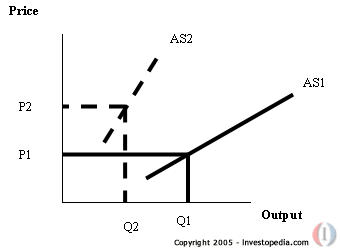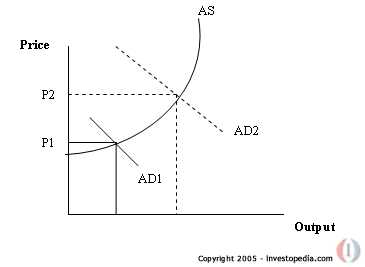Do you remember how much less you paid for things even two years ago? This increase in the general price level of goods and services in an economy is inflation, measured by the Consumer Price Index and the Producer Price Index. But there are different types of inflation, depending on its cause. Here we examine cost-push inflation and demand-pull inflation.
Factors of Inflation
Inflation is defined as the rate (%) at which the general price level of goods and services is rising, causing purchasing power to fall. This is different from a rise and fall in the price of a particular good or service. Individual prices rise and fall all the time in a market economy, reflecting consumer choices or preferences and changing costs. So if the cost of one item, say a particular model car, increases because demand for it is high, this is not considered inflation. Inflation occurs when most prices are rising by some degree across the whole economy. This is caused by four possible factors, each of which is related to basic economic principles of changes in supply and demand:
- Increase in the money supply.
- Decrease in the demand for money.
- Decrease in the aggregate supply of goods and services.
- Increase in the aggregate demand for goods and services.
In this look at what inflation is and how it works, we will ignore the effects of money supply on inflation and concentrate specifically on the effects of aggregate supply and demand: cost-push and demand-pull inflation.
Cost-Push Inflation
Aggregate supply is the total volume of goods and services produced by an economy at a given price level. When there is a decrease in the aggregate supply of goods and services stemming from an increase in the cost of production, we have cost-push inflation. Cost-push inflation basically means that prices have been "pushed up" by increases in costs of any of the four factors of production (labor, capital, land or entrepreneurship) when companies are already running at full production capacity. With higher production costs and productivity maximized, companies cannot maintain profit margins by producing the same amounts of goods and services. As a result, the increased costs are passed on to consumers, causing a rise in the general price level (inflation).
Production Costs
To understand better their effect on inflation, let's take a look into how and why production costs can change. A company may need to increases wages if laborers demand higher salaries (due to increasing prices and thus cost of living) or if labor becomes more specialized. If the cost of labor, a factor of production, increases, the company has to allocate more resources to pay for the creation of its goods or services. To continue to maintain (or increase) profit margins, the company passes the increased costs of production on to the consumer, making retail prices higher. Along with increasing sales, increasing prices is a way for companies to constantly increase their bottom lines and essentially grow. Another factor that can cause increases in production costs is a rise in the price of raw materials. This could occur because of scarcity of raw materials, an increase in the cost of labor and/or an increase in the cost of importing raw materials and labor (if the they are overseas), which is caused by a depreciation in their home currency. The government may also increase taxes to cover higher fuel and energy costs, forcing companies to allocate more resources to paying taxes.
Putting It Together
To visualize how cost-push inflation works, we can use a simple price-quantity graph showing what happens to shifts in aggregate supply. The graph below shows the level of output that can be achieved at each price level. As production costs increase, aggregate supply decreases from AS1 to AS2 (given production is at full capacity), causing an increase in the price level from P1 to P2. The rationale behind this increase is that, for companies to maintain (or increase) profit margins, they will need to raise the retail price paid by consumers, thereby causing inflation.
 |
Demand-Pull Inflation
Demand-pull inflation occurs when there is an increase in aggregate demand, categorized by the four sections of the macroeconomy: households, businesses, governments and foreign buyers. When these four sectors concurrently want to purchase more output than the economy can produce, they compete to purchase limited amounts of goods and services. Buyers in essence "bid prices up", again, causing inflation. This excessive demand, also referred to as "too much money chasing too few goods", usually occurs in an expanding economy.
Factors Pulling Prices Up
The increase in aggregate demand that causes demand-pull inflation can be the result of various economic dynamics. For example, an increase in government purchases can increase aggregate demand, thus pulling up prices. Another factor can be the depreciation of local exchange rates, which raises the price of imports and, for foreigners, reduces the price of exports. As a result, the purchasing of imports decreases while the buying of exports by foreigners increases, thereby raising the overall level of aggregate demand (we are assuming aggregate supply cannot keep up with aggregate demand as a result of full employment in the economy). Rapid overseas growth can also ignite an increase in demand as more exports are consumed by foreigners. Finally, if government reduces taxes, households are left with more disposable income in their pockets. This in turn leads to increased consumer spending, thus increasing aggregate demand and eventually causing demand-pull inflation. The results of reduced taxes can lead also to growing consumer confidence in the local economy, which further increases aggregate demand.
Putting It Together
Demand-pull inflation is a product of an increase in aggregate demand that is faster than the corresponding increase in aggregate supply. When aggregate demand increases without a change in aggregate supply, the ‘quantity supplied' will increase (given production is not at full capacity). Looking again at the price-quantity graph, we can see the relationship between aggregate supply and demand. If aggregate demand increases from AD1 to AD2, in the short run, this will not change (shift) aggregate supply, but cause a change in the quantity supplied as represented by a movement along the AS curve. The rationale behind this lack of shift in aggregate supply is that aggregate demand tends to react faster to changes in economic conditions than aggregate supply.
As companies increase production due to increased demand, the cost to produce each additional output increases, as represented by the change from P1 to P2. The rationale behind this change is that companies would need to pay workers more money (e.g. overtime) and/or invest in additional equipment to keep up with demand, thereby increasing the cost of production. Just like cost-push inflation, demand-pull inflation can occur as companies, to maintain profit levels, pass on the higher cost of production to consumers' prices.
 |
Conclusion
Inflation is not simply a matter of rising prices. There are endemic and perhaps diverse reasons at the root of inflation. Cost-push inflation is a result of decreased aggregate supply as well as increased costs of production, itself a result of different factors. The increase in aggregate supply causing demand-pull inflation can be the result of many factors, including increases in government spending and depreciation of the local exchange rate. If an economy identifies what type of inflation is occurring (cost-push or demand-pull), then the economy may be better able to rectify (if necessary) rising prices and the loss of purchasing power.
COUSTESY: INVESTOPEDIA
No comments:
Post a Comment